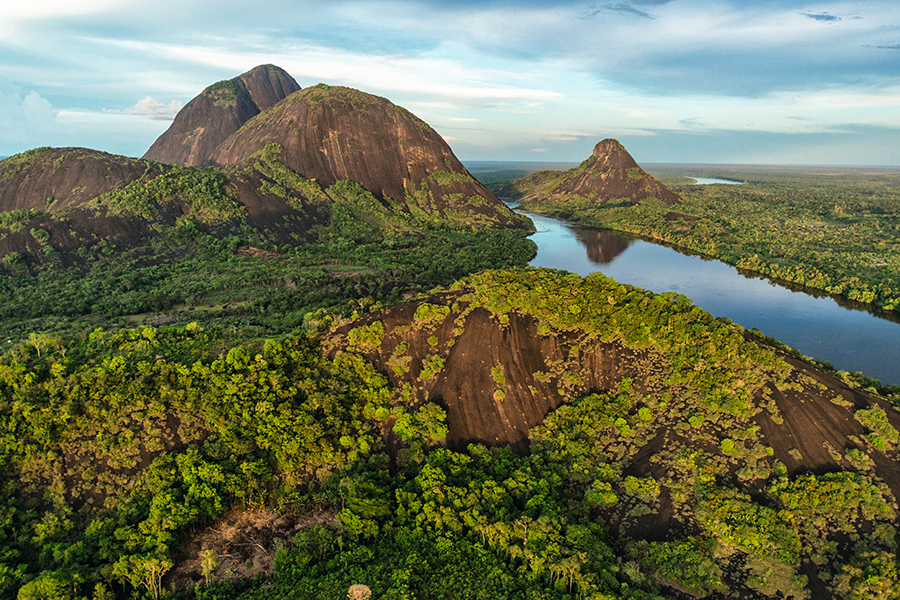COLOMBIA
COLOMBIA

At almost 2,000, Colombia is home to more bird species than any other country. Its vast national parks, varied climates and intricate eco-systems make it a haven for visitors in search of some of the world’s most exciting birds. Here are five reasons to go birdwatching in Colombia and be seduced by the country’s culture, hospitality and spirit of adventure.
1. Colombia: One of the most biodiverse countries on earth

Discover the stunning Mavecure hills in the Guainía Region.
Colombia is home to a fifth of the world’s bird species, thanks to its stunning biodiversity. Visitors can go birdwatching in Colombia in seven different eco-systems in one trip, navigating wet and dry tropical forests, wetlands, moorlands and more, in search of star species such as the Bogotá Rail and the Santa Marta Parakeet.
Whether you’re keen to explore snow-capped peaks in the Andes, palm-fringed beaches on the Caribbean and Pacific coasts, jungles in the Amazon rainforest or the vast plains of Orinoquía, Colombia has an adventure in store for you.
2. Experience unique access to wildlife

The Orinoquía Region in Colombia is home to some of the most wonderful natural landscapes.
There are 59 national parks in Colombia, all protecting outstanding wildlife. Orinoquía is home to species such as the Amazon Kingfisher and Brown Jacamar. It’s also the only place in the world where visitors can see rainbow rivers, such as Caño Cristales in the Serranía de la Macarena, transformed by rare underwater plants.
Birdwatchers who head to Colombia’s Pacific coast, in search of species such as the Blue Cotinga and Green Honeycreeper, may also spot newborn humpback whales and sea turtles laying their eggs on its beaches. Those who head south to explore the Amazon rainforest, home to the Spotted Puffbird and Chestnut-bellied Seedeater, amongst others, may also see pink river dolphins and sloths.
Colombia even boasts world-beating birdlife in its cities, from the walled city of Cartagena, a UNESCO world heritage site on the Caribbean coast, to Bogotá and Medellín, high in the Andes mountains. The Colombian Andes are home to more than 800 bird species, including the elusive Black Inca.
You might also be interested: Top 5 highlighted activities to do in Colombia by CNN Travel.
3. Explore breathtaking surroundings

Enjoy the marvelous beaches of the Caribbean Coast.
Travel to Colombia in search of birds and you’ll discover a lot more. Eleven per-cent of the country’s territory is protected, with almost half of Colombia’s stunning national parks offering once-in-a-lifetime ecotourism experiences.
Chingaza, close to Bogotá, is one of the best places for ecotourism in Colombia. The park has more than 40 glacial lakes and a delicate páramo (high moorland) ecosystem that provides habitat for birds including the Andean condor and the Brown-breasted parakeet.
Birdwatchers can also explore the stunning snow-capped volcanoes in Los Nevados, in the Coffee Cultural Landscape, in search of species such as the Buffy Helmetcrest, and Fuentes’s Parrot.
4. Immerse yourself in ancient cultures

Most of the indigenous tribes of Santa Marta identify as Kogi, Arhuaco, and Wiwa.
Colombia’s ancient origins are key to its vibrant culture. More than one million Colombians identify as indigenous, and many are keen to welcome visitors and educate them about their history, customs and beliefs. Most of Colombia’s indigenous groups live in untouched areas of the country brimming with birdlife.
The Colombian Amazon, which covers more than a quarter of the country’s territory, is home to more than 70 ethnic groups and more than 700 bird species, including macaws, toucans, parrots and antbirds. Chiribiquete and Amacayacu are some of its best national parks to visit and experience local cultures.
Colombia’s Caribbean, where more than 700 bird species have been recorded, is home to more than 30,000 indigenous people, many of them identifying as Kogui, Arhuaco and Wiwa. Most live in the Sierra Nevada de Santa Marta mountains where birdwatchers, in search of endemic species such as the White-tailed starfrontlet, can learn more about indigenous culture in Colombia.
5. Enjoy irresistible traditional music

Watch "The Birders" a documentary film that follows the journey led by Colombian birds and their sounds.
Music in Colombia is an essential part of life. The country is proud of its traditional rhythms, such as cumbia and vallenato, which bring together instruments, beats and dance steps from Colombia’s indigenous, European and African roots.
Both cumbia and vallenato are strongly influenced by the abundant birdlife of the Colombian countryside. The guacharaca, a wooden instrument used in both genres, originated among the ancient Tayrona in the Sierra Nevada and simulates the call of the Rufous-vented Chalachalaca, known locally as the guacharaca.
More than 150 vallenato songs refer to Colombian birds from 40 species, including hummingbirds, sparrowhawks, swallows, mockingbirds, condors and nightingales. Traditional vallenato makes such a vital contribution to world culture, UNESCO inscribed the genre as ‘Intangible Cultural Heritage’ in 2015.
Cumbia plays tribute to Colombian birdlife too. Popular song La Pava Congona describes the region’s cacophony of birdsong and celebrates numerous species, including the Crested Guan. This large gamebird, with its loud and distinctive song, is a popular sight on the Caribbean coast and Pava Congona is its local name.
Fascinated by the antics of colorful and curious birds? Visit a diverse country that offers exhilarating experiences in a unique and vibrant culture. Go birdwatching in Colombia, the world’s number one for bird species.



















